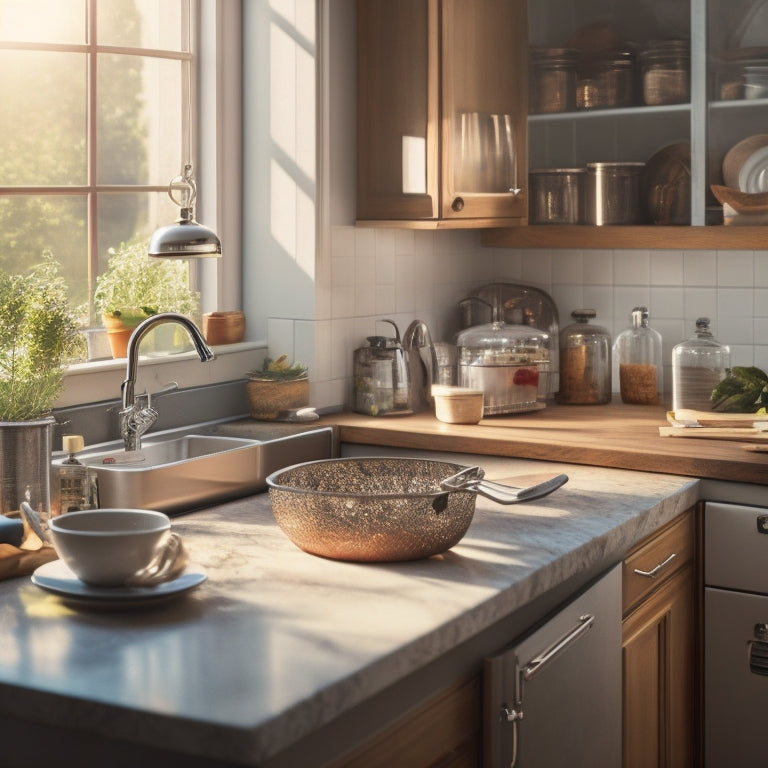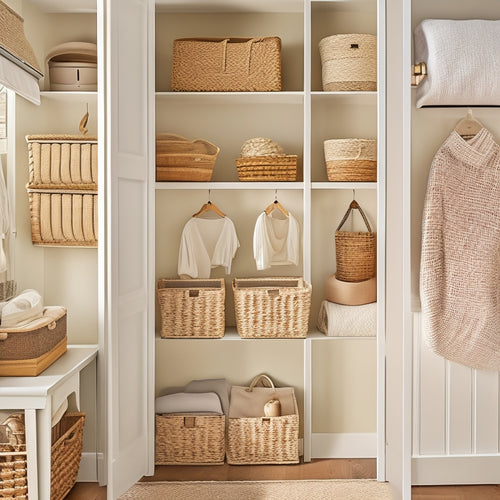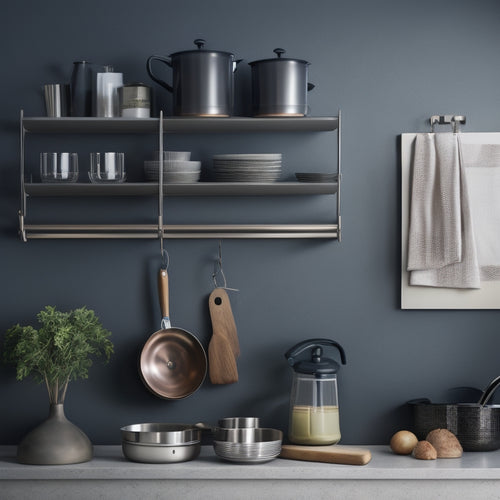
10 Best Quick Kitchen Cleaning Routines for Weekdays
Share
You can maintain a clean and organized kitchen on weekdays by incorporating simple yet effective daily routines that fit seamlessly into your busy schedule. Start with a morning mess eradication routine, followed by a 10-minute after-breakfast clean. Implement a quick wipe-down strategy and prioritize high-touch areas like countertops and sinks. Add rapid refrigerator refreshes, lunchtime sink and stove cleans, and an evening kitchen reset routine to your daily schedule. Additionally, adopt one-touch dish cleaning practices and end your day with a nightly kitchen shutdown sequence. By sticking to these routines, you'll be on your way to a clutter-free kitchen - and it's just the beginning.
Key Takeaways
• Implement a 10-minute after-breakfast clean to clear clutter, put away dishes, and wipe down surfaces.
• Designate a daily time for a quick wipe down of high-touch areas like countertops, sinks, and faucet handles.
• Perform a 60-second decluttering session to clear countertops, wipe down surfaces, and put away items.
• Establish an evening kitchen reset routine to clear countertops, wipe down sink and stove, and put away dishes and utensils.
• Use a one-touch dish cleaning system to wash dishes immediately, designate a dish station, and put away dishes promptly.
Morning Mess Eradication Routine
Morning Mess Eradication Routine
Start your day by tackling the morning mess, wiping down the counters and sink, and loading any dirty dishes into the dishwasher or washing them by hand. This daily habit sets the tone for a clutter-free kitchen and saves you time in the long run.
Focus on the breakfast cleanup, paying attention to crumbs, spills, and splatters. A quick counter wipe with a damp cloth will remove any lingering mess.
Next, tackle the sink area, scrubbing away any stuck-on food particles or stains. Don't forget to rinse and dry the sink basin to prevent water spots.
If you have a dishwasher, load it up with dirty dishes, pots, and pans. If not, wash them by hand and put them away immediately.
10-Minute After-Breakfast Clean
Now that you've tackled the morning mess, it's time for a quick after-breakfast clean.
You'll focus on maintaining control over the morning chaos and giving your kitchen a speedy wipe down.
Morning Mess Control
You can tackle the morning mess by establishing a daily habit of quickly cleaning up after breakfast, even if it's just for a minute. This daily routine will help prevent morning messes from building up and save you time in the long run. By dedicating a minute each morning to tidying up, you'll be able to enjoy a more organized kitchen and a sense of control over your day.
Here are some efficient strategies to help you achieve morning mess control:
-
Clear the clutter: Quickly put away any breakfast dishes, cups, or utensils to prevent them from piling up.
-
Wipe down surfaces: Give your counters and tables a quick wipe to remove any crumbs, spills, or sticky residue.
-
Put away ingredients: Store any leftover ingredients or breakfast items in their designated places to keep your kitchen organized.
- Take out the trash: Take a few seconds to remove any trash or recyclables from the kitchen to keep it smelling fresh and clean.
Quick Wipe Down
By incorporating a quick wipe down into your morning routine, you'll be able to tackle sticky countertops and messy tables in no time. This speedy countertop cleanup is essential in maintaining a clean kitchen. Start by grabbing a damp cloth and wiping down the counters, focusing on areas around sinks, stoves, and refrigerators. Don't forget to give your appliances a quick once-over, efficiently wiping down their surfaces to remove any splatters or spills.
Next, take a few seconds to sweep the floor, clearing away any debris or crumbs that may have accumulated overnight. This quick floor sweep will prevent dirt and dust from building up and make your kitchen feel fresher.
While you're at it, give your cabinets a quick dusting, instantly removing any visible dust or dirt. By dedicating just a minute to this quick wipe down, you'll be able to enjoy a cleaner, more organized kitchen that sets the tone for a productive day ahead.
Quick Wipe Down Strategy
Your quick wipe down strategy starts with designating a specific time slot, like right after dinner, to rapidly clear clutter and wipe down high-traffic areas. This daily habit will keep your kitchen clean and hygienic, even on the busiest weekdays.
Here's how to make the most of your quick wipe down strategy:
-
Focus on high-touch areas: Quickly wipe down countertops, sinks, and faucets to prevent the buildup of dirt and bacteria.
-
Use efficient cleaning hacks: Keep a stash of microfiber cloths and all-purpose cleaners within easy reach to speed up the process.
-
Prioritize speed over perfection: Remember, this is a quick wipe down, not a deep clean. Focus on removing visible dirt and crumbs, and save the heavy-duty cleaning for the weekends.
- Make it a habit: Try to wipe down your kitchen at the same time every day, so it becomes second nature and doesn't feel like a chore.
Speed Cleaning High-Touch Areas
When you're short on time, you can't afford to neglect high-touch areas in your kitchen, where germs and bacteria tend to accumulate. You'll want to prioritize these zones, such as faucet handles, countertops, and cabinet knobs, to prevent the spread of illness.
Daily Wipe Down Routine
Set a timer for 10 minutes each morning to quickly wipe down high-touch areas, such as faucet handles, light switches, and countertops, to prevent the buildup of germs and grime. This daily routine is essential for surface sanitization and will save you time in the long run.
To make the most of your 10-minute daily wipe down, focus on the following high-priority areas:
-
Faucet handles: Wipe down faucet handles with a disinfectant wipe to prevent the spread of germs.
-
Light switches: Quickly wipe down light switches with a dry cloth to remove dust and dirt.
-
Countertops: Wipe down countertops with a gentle cleaner to remove crumbs and spills.
- Sink basin: Give the sink basin a quick scrub with soap and water to remove any food particles.
Germs on Common Surfaces
You're probably unaware of the germ hotspots lurking in your kitchen, but by targeting common surfaces, you can greatly reduce the spread of illness. Bacteria and viruses can spread rapidly through contact with contaminated surfaces, making it essential to prioritize kitchen hygiene.
Here are some high-touch areas to focus on:
| Surface | Sanitization Tips |
|---|---|
| Countertops | Wipe down with a disinfectant solution after food prep |
| Sink | Scrub with soap and warm water after washing dishes |
| Faucet | Disinfect with a mixture of water and white vinegar |
| Refrigerator Handles | Wipe with a disinfectant wipe daily |
| Light Switches | Use a disinfectant spray and let it air dry |
Clean High-Touch Zones Fast
Clean High-Touch Zones Fast
To expedite the cleaning of high-touch zones, prioritize the most critical areas and tackle them first, focusing on the spots that require the most attention. These high-traffic zones are breeding grounds for germs and bacteria, so it's crucial to sanitize them quickly and effectively.
Here are some quick disinfection tips to help you address these areas:
-
Sink and faucet: Wipe down the sink and faucet with a disinfectant wipe to eliminate germs and bacteria that can spread illness.
-
Countertops: Use a sanitizing spray to promptly disinfect countertops, paying attention to areas around sinks, stoves, and refrigerators.
-
Door handles: Wipe down door handles with a disinfectant wipe to prevent the spread of germs and bacteria.
- Light switches: Use a sanitizing spray to promptly disinfect light switches, which are often touched but rarely cleaned.
Lunchtime Sink and Stove Clean
Tackle the lunchtime mess by wiping down the sink and stove with a damp cloth, quickly removing any food debris and spills. This daily habit will prevent crumbs and sauces from hardening, making future deep cleans a breeze.
Next, grab your trusty sink scrub and stove shine products to tackle grime and eliminate odors. Focus on high-traffic areas, like the sink basin and stove burners, where grease and grime tend to accumulate. A quick scrub and rinse will leave your sink and stove looking like new.
Don't forget to wipe down the faucet and stove knobs, too, to prevent water spots and fingerprints from building up. By incorporating this simple routine into your daily lunch break, you'll be able to maintain a clean and hygienic kitchen with minimal effort.
Plus, you'll feel more energized and focused, knowing your kitchen is sparkling clean and ready for the next meal prep.
5-Minute Clutter Control Method
In just 60 seconds, you can sweep away clutter and chaos by implementing a daily habit of rapid-fire decluttering, focusing on high-priority areas like countertops and kitchen tables. This minute clutter control method is a powerful tool for maintaining a sense of control and sanity in your kitchen.
Here's how to make the most of your 60-second decluttering session:
-
Clear off countertops: Quickly remove any items that don't belong, such as dirty dishes, appliances, or food prep tools.
-
Wipe down surfaces: Use a damp cloth to wipe down kitchen tables, countertops, and any other surfaces that need it.
-
Put away items: Return items to their designated storage spaces, such as utensils, spices, or cookbooks.
- Take out the trash: Remove any full trash bags or recyclables to keep your kitchen smelling fresh and clean.
Rapid Refrigerator Refresh
You're just a few minutes away from a fresher, more organized fridge. To get started, you'll focus on three key tasks:
wiping down shelves daily,
tossing expired food items,
and organizing fresh food zones.
Wipe Down Shelves Daily
Clean off cluttered shelves in a flash by grabbing a damp cloth and swiftly wiping down every surface, from the refrigerator's top shelf to the crisper drawers. This daily habit will keep your kitchen hygienic and organized, making weekly pantry organization a breeze. By wiping down shelves daily, you'll prevent crumbs, spills, and stains from building up, making it easier to maintain your kitchen's overall cleanliness.
Here are some benefits of incorporating this habit into your daily routine:
-
Reduces crumbs and spills: Wiping down shelves daily prevents crumbs and spills from accumulating, making it easier to clean and reducing the risk of pest infestations.
-
Improves kitchen hygiene: Regularly wiping down shelves helps maintain kitchen hygiene, reducing the risk of cross-contamination and keeping your kitchen a healthy space.
-
Saves time: By wiping down shelves daily, you'll save time in the long run by preventing the buildup of stubborn stains and spills.
- Enhances shelf maintenance: Daily wiping helps maintain your shelves, keeping them in good condition and extending their lifespan.
Toss Expired Food Items
Take a few minutes each day to toss expired food items from your refrigerator and freezer, making room for fresh groceries and ensuring a healthier, more organized kitchen. This daily habit will help you maintain a clutter-free pantry organization and prevent spoiled food from taking over your shelves.
As you perform your daily fridge inspection, check expiration dates and toss anything that's past its prime. Be ruthless – if it's expired, it's time to let it go. This won't only free up space but also reduce the risk of foodborne illnesses.
Don't forget to check the freezer too, where expired or spoiled items can lurk. Remove any questionable items and wipe down the shelves to prevent cross-contamination.
Organize Fresh Food Zones
With your fridge cleared of expired items, now it's time to create zones for fresh food, grouping similar items together to guarantee everything has a designated spot and is easily accessible when you need it. This will help you maintain a sense of control and make meal prep a breeze.
To get started, consider the following zones:
-
Dairy and Eggs: Store milk, yogurt, cheese, and eggs in the same area for easy access.
-
Fresh Produce: Designate a shelf for fruits and vegetables, keeping them visible and within reach.
-
Meat and Protein: Group raw meats, poultry, and seafood together, and store them at the bottom of the fridge to prevent cross-contamination.
- Leftovers and Ready-to-Eat: Reserve a shelf for cooked meals and ready-to-eat items, making it easy to grab and go.
Evening Kitchen Reset Routine
You'll want to establish a consistent evening kitchen reset routine to maintain a sense of organization and control in your kitchen. This daily habit will help you unwind and prepare for the next day, allowing you to enjoy evening relaxation and focus on weekend meal prep.
| Task | Time | Benefits |
|---|---|---|
| Clear countertops | 5 minutes | Reduces clutter, creates space |
| Wipe down sink and stove | 5 minutes | Eliminates crumbs, prevents mess |
| Put away dishes and utensils | 10 minutes | Saves time in the morning, reduces chaos |
| Plan tomorrow's meals | 10 minutes | Streamlines grocery shopping, saves money |
| Take out the trash and recycling | 5 minutes | Maintains a clean and hygienic environment |
One-Touch Dish Cleaning System
Implement a one-touch dish cleaning system to save time and energy by washing and putting away dishes immediately after meals. This habit helps you maintain a clean kitchen and avoids the build-up of dirty dishes. By adopting this system, you'll reduce your overall cleaning time and enjoy a more organized kitchen.
Here are some tips to help you implement a one-touch dish cleaning system:
-
Wash dishes immediately: Try to wash dishes as soon as you're done eating to avoid food residue from hardening.
-
Designate a dish station: Assign a specific area for washing and drying dishes to keep your kitchen organized.
-
Use a dish rack: Invest in a dish rack to dry and store clean dishes, keeping them off countertops and out of the way.
- Put away dishes promptly: Once dishes are dry, put them away in their designated storage spaces to maintain a clutter-free kitchen.
Nightly Kitchen Shutdown Sequence
To maintain a clean and organized kitchen, complete a nightly shutdown sequence by tackling a few key tasks before calling it a day. This routine will help you stay on top of kitchen organization and secure a smooth morning routine.
First, tidy up your kitchen counters by putting away any clean dishes, appliances, and utensils.
Then, take a few minutes to prep for the next day by setting out ingredients and tools needed for weekly meal prep. This will save you time and energy in the long run.
Next, quickly wipe down the kitchen pantry and fridge to prevent crumbs and spills from building up. This habit will keep your kitchen organization on track and deter pests from being attracted to your kitchen.
Frequently Asked Questions
How Do I Maintain Cleaning Routines With a Busy Schedule?
Did you know 80% of people struggle with maintaining cleaning routines? You can overcome this by prioritizing time management and organization. Implement cleaning hacks like 10-minute daily tidies and zone cleaning to boost efficiency, making the most of your busy schedule.
Can These Routines Be Adapted for a Large Family?
When hosting large gatherings, you'll need to adapt your cleaning routine for efficiency. Manage your time by delegating tasks to family members, ensuring a spotless kitchen without sacrificing precious time.
What Are the Most Essential Cleaning Products to Have on Hand?
You'll want to stock up on natural alternatives like baking soda and vinegar, plus disinfecting wipes for tough messes. For efficiency, invest in multi-purpose cleaners that tackle multiple tasks, saving you time and energy.
How Do I Clean With Pets and Kids Constantly in the Way?
When you're cleaning with pets and kids around, you're constantly managing distractions. Try breaking tasks into smaller chunks, setting timers, and using pet-friendly products to make efficient cleaning a breeze, saving you time and energy.
Are These Routines Suitable for a Small Kitchen With Limited Storage?
"In your compact kitchen, every inch counts. You'll breathe easier when you maximize space by implementing efficient organization strategies, like vertical storage and multi-functional tools, to keep your kitchen tidy and functional, even with limited square footage."
Related Posts
-

7 Best Budget-Friendly DIY Closet Organization Hacks
You can transform your cluttered closet into a serene oasis without breaking the bank! Repurpose old furniture pieces...
-

Corner Kitchen Utensil Storage Solutions
You're likely wasting up to one-third of your cabinet space in corner areas, but with the right storage solutions, yo...

